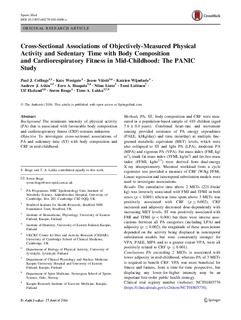| dc.contributor.author | Collings, Paul J. | |
| dc.contributor.author | Westgate, Kate | |
| dc.contributor.author | Väistö, Juuso | |
| dc.contributor.author | Wijndaele, Katrien | |
| dc.contributor.author | Atkin, Andrew J. | |
| dc.contributor.author | Haapala, Eero A. | |
| dc.contributor.author | Lintu, Niina | |
| dc.contributor.author | Laitinen, Tomi | |
| dc.contributor.author | Ekelund, Ulf | |
| dc.contributor.author | Brage, Søren | |
| dc.contributor.author | Lakka, Timo A. | |
| dc.date.accessioned | 2017-03-01T08:39:47Z | |
| dc.date.available | 2017-03-01T08:39:47Z | |
| dc.date.issued | 2016-08-24 | |
| dc.identifier.citation | Sports Medicine. 2016, under utgivelse. doi:10.1007/s40279-016-0606-x | nb_NO |
| dc.identifier.uri | http://hdl.handle.net/11250/2432467 | |
| dc.description.abstract | Background: The minimum intensity of physical activity (PA) that is associated with favourable body composition and cardiorespiratory fitness (CRF) remains unknown. Objective: To investigate cross-sectional associations of PA and sedentary time (ST) with body composition and CRF in mid-childhood. Methods: PA, ST, body composition and CRF were measured in a population-based sample of 410 children (aged 7.6 ± 0.4 years). Combined heart-rate and movement sensing provided estimates of PA energy expenditure (PAEE, kJ/kg/day) and time (min/day) at multiple fine-grained metabolic equivalent (MET) levels, which were also collapsed to ST and light PA (LPA), moderate PA (MPA) and vigorous PA (VPA). Fat mass index (FMI, kg/m2), trunk fat mass index (TFMI, kg/m2) and fat-free mass index (FFMI, kg/m2.5) were derived from dual-energy X-ray absorptiometry. Maximal workload from a cycle ergometer test provided a measure of CRF (W/kg FFM). Linear regression and isotemporal substitution models were used to investigate associations. Results: The cumulative time above 2 METs (221 J/min/kg) was inversely associated with FMI and TFMI in both sexes (p < 0.001) whereas time spent above 3 METs was positively associated with CRF (p ≤ 0.002); CRF increased and adiposity decreased dose-dependently with increasing MET levels. ST was positively associated with FMI and TFMI (p < 0.001) but there were inverse associations between all PA categories (including LPA) and adiposity (p ≤ 0.002); the magnitude of these associations depended on the activity being displaced in isotemporal substitution models but were consistently stronger for VPA. PAEE, MPA and to a greater extent VPA, were all positively related to CRF (p ≤ 0.001). Conclusions: PA exceeding 2 METs is associated with lower adiposity in mid-childhood, whereas PA of 3 METs is required to benefit CRF. VPA was most beneficial for fitness and fatness, from a time-for-time perspective, but displacing any lower-for-higher intensity may be an important first-order public health strategy. | nb_NO |
| dc.language.iso | eng | nb_NO |
| dc.publisher | Springer | nb_NO |
| dc.subject | physical activity | |
| dc.subject | body composition | |
| dc.subject | sleep duration | |
| dc.subject | sedentary time | |
| dc.subject | cardiorespiratory fitness | |
| dc.title | Cross-Sectional Associations of Objectively-Measured Physical Activity and Sedentary Time with Body Composition and Cardiorespiratory Fitness in Mid-Childhood: The PANIC Study | nb_NO |
| dc.type | Journal article | nb_NO |
| dc.type | Peer reviewed | nb_NO |
| dc.subject.nsi | VDP::Samfunnsvitenskap: 200::Samfunnsvitenskapelige idrettsfag: 330::Andre idrettsfag: 339 | nb_NO |
| dc.source.journal | Sports Medicine | nb_NO |
| dc.identifier.doi | 10.1007/s40279-016-0606-x | |
| dc.description.localcode | Seksjon for idrettsmedisinske fag / Department of Sports Medicine | nb_NO |
